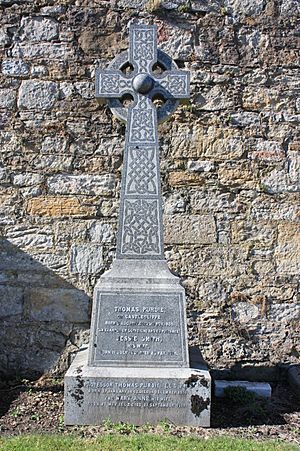Thomas Purdie facts for kids
Quick facts for kids
Thomas Purdie
|
|
|---|---|

The grave of Prof Thomas Purdie, St Andrews Cemetery east
|
|
| Born | 27 January 1843 |
| Died | 14 December 1916 (aged 73) St Andrews
|
| Resting place | St Andrews |
| Nationality | Scottish |
| Spouse(s) | Mary Anne Purdie |
| Scientific career | |
| Fields | Organic chemistry |
| Institutions | University of St Andrews |
| Doctoral advisor | Johannes Wislicenus |
| Notable students | Alexander McKenzie |
Thomas Purdie was an important Scottish chemist who lived from 1843 to 1916. He is famous for his work on understanding how simple sugars are built. He worked closely with another chemist named James Irvine. Today, a building at the University of St Andrews is named after him. This building is where the School of Chemistry is located, a school he helped create!
About Thomas Purdie
Thomas Purdie was born in Biggar, South Lanarkshire, Scotland, on January 27, 1843. When he was young, his family lived in South America for seven years. Later, his father bought a house in St Andrews. After talking with a famous scientist named Thomas Henry Huxley, Thomas decided to become a chemist.
Around 1871, he started studying at the Royal School of Mines in London. He then went to Würzburg University in Germany. There, he earned a special degree called a PhD in Chemistry. After that, he taught chemistry in different places, including South Kensington and Newcastle-under-Lyme.
Professor of Chemistry
In 1884, Thomas Purdie became a Professor of Chemistry at St Andrews University. He taught many students, including one who became famous, Alexander McKenzie. In 2014, a very old periodic table chart was found at St Andrews. It was discovered that Professor Purdie had bought it way back in 1885!
Professor Purdie retired from teaching in 1909. He passed away in St Andrews on December 14, 1916. He is buried with his parents in the cemetery near St Andrews Cathedral.

